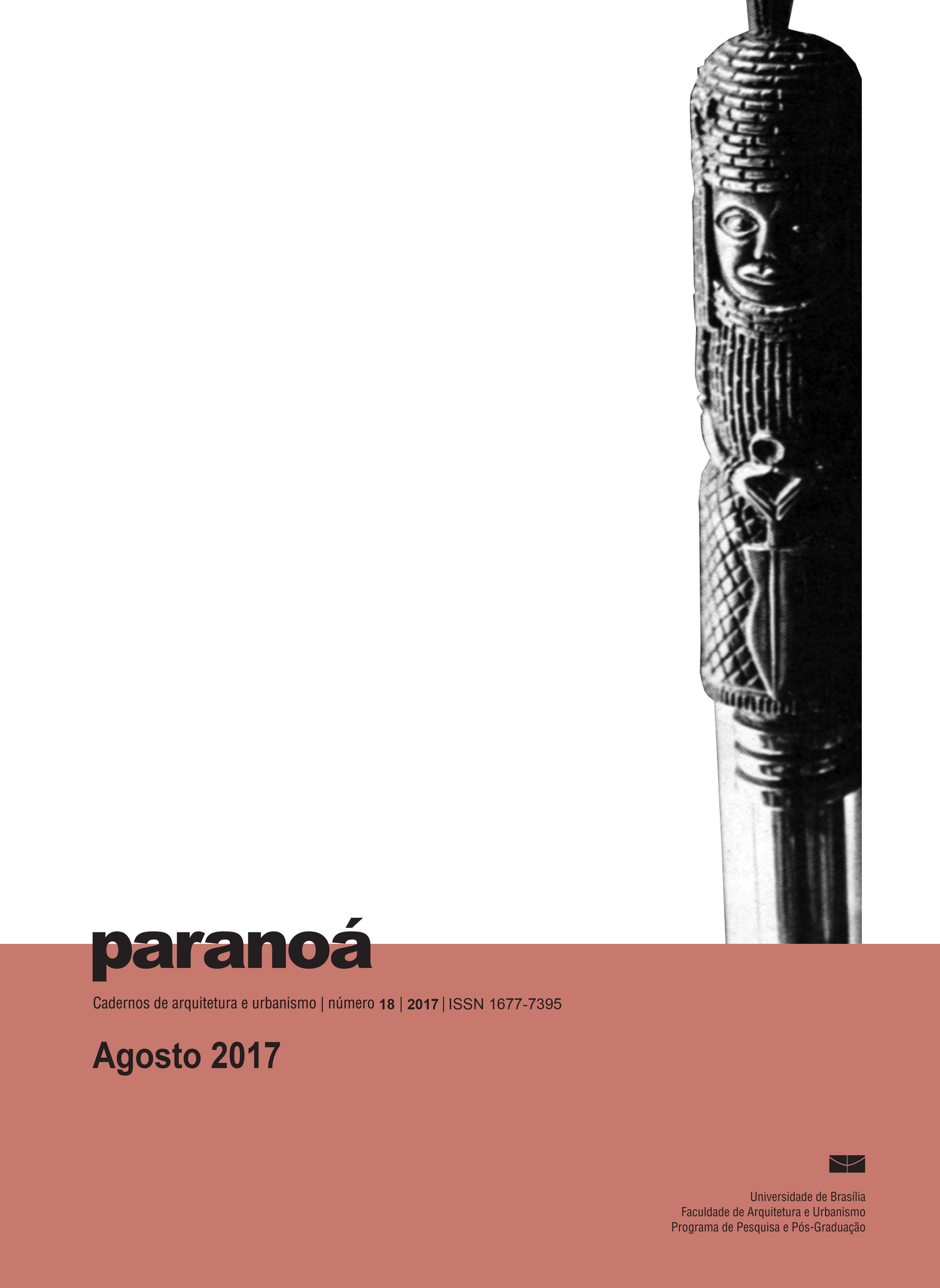Modern Movement mediations: brazilian Modernism and the identity of post-war Architecture in Pretoria, South Africa
DOI:
https://doi.org/10.18830/issn.1679-0944.n18.2017.04Keywords:
Modern Movement, Brazil Builds, Hellmut stauch, Oscar NiemeyerAbstract
The brazilian architecture of Oscar Niemeyer inspired the design of a number of South African buildings. This article will contextualise modern movement mediations and will highlight similarities in approach to identity, context and a range of efficiencies through a comparison of Oscar Niemeyer's 1945 Ministry of Education and Health Building in Rio de Janeiro and Helmut Stauch's 1952 Meat Board Building in Pretoria.
Downloads
References
ANON. Meat Board Building, Pretoria. Architect and Builder. September, p. 54-61, 1952.
ANON. Modular office building. Architectural Forum, February. p. 146-149, 1953a.
ANON. Three Pretoria Houses. Architect and Builder, April, p. 34-49, 1953b.
Barber. D. Le Corbusier. The Brise Soleil and the Socio-Climatic Project of Modern Architecture. Retrieved from <http://www.academia.edu/10112316/Le_Corbusier_The_Brise-Soleil_and_the_Socio-Climatic_Project_of_Modern_Architecture_1929-1963> [Accessed 16 March 2017].
BARKER, A. Heterotrophic syntheses: mediation in the domestic architecture of Gabriël (Gawie) Fagan. Pretoria: Unpublished PhD, University of Pretoria, 2012.
BENTON, T. The Modernist House. London: V&A Publications, 2006.
CHIPKIN, Clive M. Johannesburg Style: Architecture and Society 1880s ”“ 1960s. Cape Town: David Philip, 1993.
CLARKE, N. Architectural history of the capital. In Matthews, P.J. (ed.).
Contemporary capital: an architectural journal. Pretoria: Visual Books, 2011.
COOKE, J. A biographical history: Helmutt (sic) Stauch. In Beck, H. (ed.). UIA International Architect: Southern Africa, (8), p. 61, 1985.
COOKE, J. Revisions of the Modern. In Architecture of the Transvaal. Edited by R.C. Fisher & S. le Roux with E. Maré. Pretoria: University of South Africa, 1998, p. 231-251.
COOKE, J. Shifts after the Thirties. Architecture South Africa, (7/8), July/August, p. 23-30, 1993.
CURTIS, W. Modern Architecture since 1900. London: Phaidon, 1996.
DE BEER, I. Brazil. In Architecture 2000. Edited by I. Prinsloo. Johannesburg: Picasso Headline, p. 109-110, 2000.
FAGAN, G.T. & G. Interview with the author on 26 March 2008. 156 Bree Street, Cape Town, 2008.
FASSLER, J. Contemporary Architecture in South Africa. Architectural Design. June (6), p. 176-179, 1956.
FISHER, R.C. The Third vernacular. Pretoria Regionalism - aspects of an emergence. In Architecture of the Transvaal. Edited by R.C. Fisher & S. le Roux with E. Maré. Pretoria: University of South Africa, 1998, p. 123-147.
GERNEKE, G. Oscar Ribbeiro de Almeida Niemyer Soares Filho (1907-2012). Architecture South Africa. Issue 65, Jan/Feb, 2014, p. 39-45.
GERNEKE, G. From Brazil to Pretoria ”“ The Second Wave of the Modern Movement. In Architecture of the Transvaal, First edition, edited by R.C. Fisher, S. le Roux & E. Mare. Pretoria: University of South Africa, 1998, p. 216-217 & 224 ill.
GHIRADO, D. Architecture after Modernism. Thames & Hudson, 1996.
GOODWIN, Philip L. BRAZIL BUILDS. Design; Mar 1, 44, 7; Periodicals Archive Online, p. 10, 1943b.
GOODWIN, Philip L. BRAZIL BUILDS. Museum of Modern Art, New York, 1943a.
HERBERT, G. Martienssen and the International Style: the modern movement in South African Architecture. Cape Town: A.A. Balkema, 1975.
HEYNEN, H. Architecture and Modernity. Cambridge: MIT Press, 1999.
HOWIE, W.D. 'The Meat Board building, Pretoria'. South African Architectural Record, September, p. 212-222, 1952.
JENCKS, C. Modern Movements in Architecture. Garden City, N.Y: Penguin, 1985.
JOEDICKE, J. Architecture since 1945. London: Pall Mall, 1969.
Lexicon. Little Brazil. Artefacts. 2017. Retrieved from.
http://www.artefacts.co.za/main/Buildings/style_det.php?styleid=70 [Accessed 14 March 2017].
MCINTOSH, W.G. Pretoria's architecture: present and future. South African Architectural Record, May, p. 22-23, 1956.
Meat Board Building, 140 Hamilton Avenue, Arcadia, Tshwane. Ablewiki. 2010. ABLEWIKI:NipilarHouse. Retrieved from <http://wiki.up.ac.za/index.php/ABLEWIKI:NipilarHouse> [Accessed 14 March 2017].
MULLER, C.J.F. Five Hundred Years - A history of South Africa. Pretoria, Cape Town: Academica, 1984.
NATION, S. The background, architectural philosophy and work of Hellmutt Wilhelm Ernst Stauch. Unpublished Master's thesis. University of Pretoria: Pretoria, 1985.
PETERS, W. Houses for Pretoria. In Architecture of the Transvaal. Edited by R.C. Fisher & S. le Roux with E. Maré. Pretoria: University of South Africa, 1998, 175-195.
PETERS, W. The importance of the '30s in the Domestic Architecture of Hellmut Stauch. Architecture South Africa, January/February, p. 23-29, 1987.
PEVSNER, N. Johannesburg: Meat Board Building. The Architectural Review. Vol. 113. Number 678. June, p. 375, 1953.
PRINSLOO, I. (ed.). Architecture 2000: A review of South African Architecture. Johannesburg: Picasso Headline, 2000.
SILVERMAN, M. 'Ons bou vir die Bank': Nationalism, architecture and Volkskas Bank' in Blank, Architecture Apartheid and After. 1999, p. 129-143.
ST. JOHN WILSON, C. The other tradition of Modern Architecture - the uncompleted project. London: Blackdog, 2007.
STAUCH, H.W.E. 'A modern office building'. REPRINT: Public Works of South Africa, July p. 1-8, 1951.
Downloads
How to Cite
Issue
Section
License
Autores que publicam nesta revista concordam com os seguintes termos:
- Autores mantém os direitos autorais e concedem à revista o direito de primeira publicação, com o trabalho simultaneamente licenciado sob a Licença Creative Commons Attribution que permite o compartilhamento do trabalho com reconhecimento da autoria e publicação inicial nesta revista. http://creativecommons.org/licenses/by/4.0
- Autores têm autorização para assumir contratos adicionais separadamente, para distribuição não-exclusiva da versão do trabalho publicada nesta revista (ex.: publicar em repositório institucional ou como capítulo de livro), com reconhecimento de autoria e publicação inicial nesta revista.
- Autores têm permissão e são estimulados a publicar e distribuir seu trabalho online (ex.: em repositórios institucionais ou na sua página pessoal) a qualquer ponto antes ou durante o processo editorial, já que isso pode gerar alterações produtivas, bem como aumentar o impacto e a citação do trabalho publicado (Veja O Efeito do Acesso Livre).















